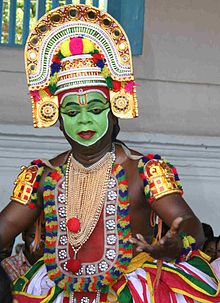- Ottamthullal
-
Ottamthullal or Ottanthullal (Malayalam:ഓട്ടന് തുള്ളല്, pronounced [oːʈːamt̪uɭːal]) is a type of performing art from Kerala, India. The art form was created during the 18th century by legendary Malayalam poet Kalakkaththu Kunchan Nambiar. The story goes that Nambiar, who was playing the mizhavu for a Chakyar Koothu show, dozed off in the middle of the performance, thus inviting ridicule from the Chakyar. A humiliated Nambiar vowed to come up with an alternative art form to Chakyar koothu, and conjured up an Ottamthullal show that also made fun of prevalent socio-political equations and prejudices of the region.
Ottamthullal, over the centuries, has a (mostly) single actor, donning a green make-up and wearing colourful costumes (which once prompted Pt Jawaharlal Nehru to once remark that Ottamthullal is "poor man's Kathakali") and reciting the thullal lyrics (dance songs), all the while acting and dancing himself. The art form has of late found practitioners from among women too, and is occasionally staged as a group dance form with each artiste representing a character in the storyplay.
The art form still retains its satirical touch, and lends the artiste the freedom to improvise, more so on humour. Its incidental satire makes this art form more popular among the common man. Unlike in the case of Kathakali, the language is pretty Malayalam and the lyrics are set to rhythms that range from simple to rare and complicated.
== Among the classical performing arts of Kerala, Thullal is distinct with its simplicity of presentation and its frank, outspoken wit and humour. The songs are in simple Malayalam and the techniques employed in this art are not rigid, though they are based on the classical principles of Naatya Saastra, a treatise on art originating in the 2nd century B.C. it is said to have been a modification of Koothu.
More PicturesThe word Thullal belongs to the Dravidian family of languages and literally means jumping, this however can be extended to mean to ‘to leap about’ or to ‘cut a caper’.
Thullal is also a genre of poetry in Malayalam. It is significant that the work is composed in metres that later became the norm for Thullal poetry. This seems to indicate that the songs for Thullal dance, at least in their structure, took their inspiration from a model that was already available. Though the Thullal dance, as we know it, came into existence less than 200years ago, the roots of its verbal component can well be traced to at least one century earlier.
Thullal is said to have been organized by Kunjan Nambiar, a veritable genius and one of the foremost poets of Kerala. Oral history records that Kunjan Nambiar accompanied the Chaakiaars on the drums when they performed their heredictary occupation of dance and drama. One day, during a temple festival, when Kunjan Nambiar was playing the drum for a Chaakiaar, he made a mistake. This incensed the Chaakiaar so much that he publicly took him to task. Crestfallen, Nambiar quietly left. Seething inwardly with anger however, he returned the following day when the same Chaakiaar was performing. Altired in a manner that itself was enough to attract attention, he presently began to sing and dance. In no time the audience turned around only to lose itself in Nambiar’s antics, leaving the Chaakiaar without spectators.
The story Kunjan Nambiar presented was a familiar one, the Kalyaanasaugandhikam from the Mahabhaaratha, but he clothed it with his own words. The Chaakiaar momentarily defeated, was silent, but later took his revenge by persuading the ruler, the Raja of Ambalapuzha, to forbid Kunjan Nambiar from performing or visiting there again.
There are three different types of Thullal, classified according to the metre and rhythm of the songs sung in each one and the differences in costume and dance. They are Ottan Thullal, Seethankan Thullal and Parayan Thullal.
The precise interpretation of the labels Seethankan, Parayan and Ottan is not clear, but the difference in the styles relates mainly to the metre of the poetry, the place of the singing, and the costume and adornment of the performer.
Kunjan Nambiar, for his inspiration, turned to legend and mythology but gave to each story or episode a totally contemporary slant. He took figures from the Raamaayana and Mahabhaarata, the Bhaagavatham and other Puraanas and exposed them to the modes and mores of the society of his time. He was a poet of the soil who, through the expedient of wit and satire, ruthlessly laid bare the hypocrisy that he saw around him in everyday life. Making no effort to deliver a message or spell out a moral, he was content to present the picture as he saw it, and left it to his audience to react as they wished. He excelled in fusing reality with fantasy and made his characters appear totally valid to the scenario of his time. To this day, Nambiar remains the unquestioned master of the this art.
See also
- Arts of Kerala
- Killikkurussimangalam
- Mani Madhava Chakyar
- Chakyar koothu
- Kathakali
- Mohiniyattam
- Koodiyattam
- Panchavadyam
- Kerala Kalamandalam
Categories:- Hindu traditions
- Dances of India
- Arts of Kerala
- Indian dance stubs
- Comedy stubs
Wikimedia Foundation. 2010.

